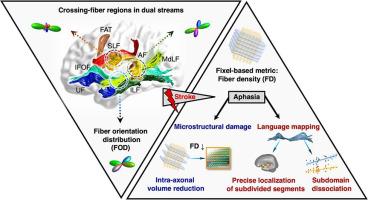NeuroImage: Clinical ( IF 4.2 ) Pub Date : 2021-07-25 , DOI: 10.1016/j.nicl.2021.102774 Jie Zhang 1 , Weihao Zheng 2 , Desheng Shang 3 , Yating Chen 4 , Shuchang Zhong 4 , Jing Ye 4 , Lingling Li 5 , Yamei Yu 6 , Li Zhang 4 , Ruidong Cheng 4 , Fangping He 5 , Dan Wu 7 , Xiangming Ye 4 , Benyan Luo 8

|
Background
The complex crossing-fiber characteristics in the dual-stream system have been ignored by traditional diffusion tensor models regarding disconnections in post-stroke aphasia. It is valuable to identify microstructural damage of crossing-fiber pathways and reveal accurate fiber-specific language mapping in patients with aphasia.
Methods
This cross-sectional study collected magnetic resonance imaging data from 29 participants with post-stroke aphasia in the subacute stage and from 33 age- and sex-matched healthy controls. Fixel-based analysis was performed to examine microstructural fiber density (FD) and bundle cross-section alterations of specific fiber populations in crossing-fiber regions. Group comparisons were performed, and relationships with language scores were assessed.
Results
The aphasic group exhibited significant fixel-wise FD reductions in the dual-stream tracts, including the left inferior fronto-occipital fasciculus (IFOF), arcuate fasciculus, and superior longitudinal fasciculus (SLF) III (family-wise-error-corrected p < 0.05). Voxel- and fixel-wise comparisons revealed mismatched distributions in regions with crossing-fiber nexuses. Fixel-wise correlation analyses revealed significant associations between comprehension impairment and reduced FD in the temporal and frontal segments of the left IFOF, and also mapped naming ability to the IFOF. Average features along the whole course of dominant tracts assessed with tract-wise analyses attributed word-level comprehension to the IFOF (r = 0.723, p < 0.001) and revealed a trend-level correlation between sentence-level comprehension and FD of the SLF III (r = 0.451, p = 0.021). The mean FD of the uncinate fasciculus (UF) and IFOF correlated with total and picture naming scores, and the IFOF also correlated with responsive naming subdomains (Bonferroni corrected p < 0.05).
Conclusions
FD reductions of dual streams suggest that intra-axonal volume reduction constitutes the microstructural damage of white matter integrity in post-stroke aphasia. Fixel-based analysis provides a complementary method of language mapping that identifies fiber-specific tracts in the left hemisphere language network with greater specificity than voxel-based analysis. It precisely locates the precise segments of the IFOF for comprehension, yields fiber-specific evidence for the debated UF-naming association, and reveals dissociative subdomain associations with distinct tracts.
中文翻译:

基于 Fixel 的交叉通路微结构损伤证据改善了中风后失语症的语言映射
背景
传统的扩散张量模型忽略了双流系统中复杂的交叉纤维特性,这些模型关于中风后失语症的断开连接。识别交叉纤维通路的微观结构损伤并揭示失语症患者准确的纤维特异性语言映射是有价值的。
方法
这项横断面研究收集了 29 名亚急性期卒中后失语症参与者和 33 名年龄和性别匹配的健康对照组的磁共振成像数据。进行了基于 Fixel 的分析,以检查交叉纤维区域中特定纤维种群的微观结构纤维密度 (FD) 和束横截面变化。进行了组比较,并评估了与语言分数的关系。
结果
失语症组在双流束中表现出显着的固定方向 FD 减少,包括左下额枕叶束 (IFOF)、弓状束和上纵束 (SLF) III(家庭方面的错误校正 p < 0.05)。体素和固定素方面的比较揭示了交叉纤维连接区域的不匹配分布。Fixel-wise 相关分析揭示了理解障碍与左侧 IFOF 颞叶和额叶节段 FD 减少之间存在显着关联,并将命名能力映射到 IFOF。使用逐条分析评估的主导区域整个过程的平均特征将单词级理解归因于 IFOF(r = 0.723,p < 0.001),并揭示了句子级理解与 SLF III 的 FD 之间的趋势级相关性(r = 0。451,p = 0.021)。钩状束 (UF) 和 IFOF 的平均 FD 与总分和图片命名分数相关,IFOF 还与响应性命名子域相关秒 (Bonferroni 校正 p < 0.05)。
结论
双流的 FD 减少表明轴突内体积减少构成了中风后失语症中白质完整性的微观结构损伤。基于 Fixel 的分析提供了一种互补的语言映射方法,该方法比基于体素的分析具有更大的特异性,可识别左半球语言网络中的特定纤维束。它精确定位 IFOF 的精确部分以供理解,为有争议的 UF 命名关联提供特定于纤维的证据,并揭示具有不同区域的分离子域关联。



























 京公网安备 11010802027423号
京公网安备 11010802027423号